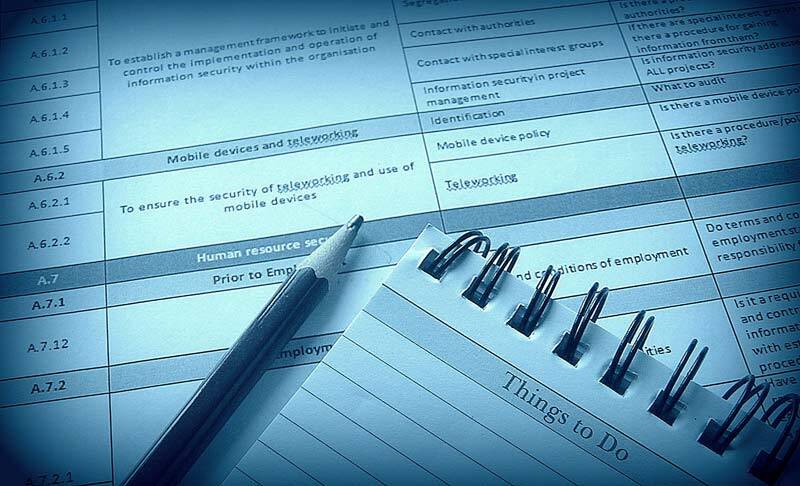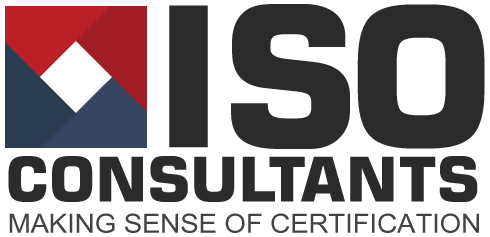The ISO 27001 Audit Checklist – Some Basics

If you are planning your ISO 27001 audit, you may be looking for some kind of an ISO 27001 audit checklist, such a as free ISO PDF Download to help you with this task.
Although they are helpful to an extent, there is no tick-box universal checklist that can simply be “ticked through” for ISO 27001 or any other standard.
Every company is different. And if an ISO management system for that company has been specifically written around it’s needs (which it should be!), each ISO system will be different. The internal auditing process will be different. We explain this in more depth elsewhere in our blogs. You could always call us, too!
However, you can create your own basic ISO 27001 audit checklist, customised to your organisation, without too much trouble. Read on to find out how.
Basics
By the way, We’re taking a broad, simple approach in this blog. But for the best results, we’d recommend some training to make the whole process much easier. However, sharing some basics will, at least, demystify the process and provide a basic framework.
And these broad principles are applicable for internal audit of other standards, such as ISO 9001, ISO 14001, etc.:
So, some basic steps in the process:-
Document review.
Quite simple! Read your Information Security Management System (or part of the ISMS you are about to audit). You will need to understand processes in the ISMS, and find out if there are non-conformities in the documentation with regard to ISO 27001. A call to your friendly ISO Consultant might help here if you get stuck(!)
Creating the checklist.
Also quite simple – make a checklist based on the document review, i.e., read about the specific requirements of the policies, procedures and plans written in the documentation and write them down so that you can check them during the main audit. For example, if the data backup policy requires the backup to be made every 6 hours, then you have to note this in your checklist in order to check if it really does happen. Take time and care over this! – it is foundational to the success and level of difficulty of the rest of the internal audit, as will be seen later.
Planning the main audit.
Or “make an itinerary for a grand tour”(!) . Plan which departments and/or locations to visit and when – your checklist will give you an idea on the main focus required.
Performing the main audit.
It is astonishingly practical! Walk around the company talk to staff, check computers and other equipment, observe physical security, etc. Your previously-prepared ISO 27001 audit checklist now proves it’s worth – if this is vague, shallow, and incomplete, it is probable that you will forget to check many key things. And you will need to take detailed notes.
Reporting.
Summarize all the non-conformities and write the Internal audit report. With the checklist and the detailed notes, a precise report should not be too difficult to write. From this, corrective actions should be easy to record according to the documented corrective action procedure.
Follow-up.
It’s the internal auditor’s job to check whether all the corrective actions identified during the internal audit are addressed. The checklist and notes from “walking around” are once again crucial as to the reasons why a nonconformity was raised. The internal auditor’s job is only finished when these are rectified and closed, and the ISO 27001 audit checklist is simply a tool to serve this end, not an end in itself!
Checklist Format – Some Basic Guidelines
A suggestion to aid simplicity! We’d recommend 4 columns as follows:-
Reference – e.g. the clause number, section number of a policy, within the standard.
What to look for – what to examine, monitor, etc., during the main audit – whom to speak to, which questions to ask, records to look for, facilities to visit, equipment to check, etc.
Compliance – Simply, has the company has complied with the requirement? Yes or No, or occasionally “not applicable”.
Findings – Details of the more-specific “findings” of the main audit I.e. staff spoken to, quotes of what they said, IDs and content of records examined, description of facilities visited, observations about the equipment checked, etc.
So,the internal audit of ISO 27001, based on an ISO 27001 audit checklist, is not that difficult – it is rather straightforward: you need to follow what is required in the standard and what is required in the documentation, finding out whether staff are complying with the procedures.
With a good ISO 27001 audit checklist audit checklist, your task will certainly be a lot easier.
And if you need our help, or even want us to run some training for you, please drop us a line! .


Great strategies you shared. I am new to the scene. I will be implementing these tomorrow. Thanks!